If the title of this post does nothing for you, stop for a minute and listen. The sounds you hear are squeals of excitement and moans of hunger from all the people for whom the three words zha jiang mian evoke yearning memories of their favorite comfort food, a deeply flavorful noodle bowl from childhood.
A Chinese-Korean hybrid, zha jiang mian may soon join the noodle bowls from around the world – ramen, pho, pad thai – that have become mainstream American fare. Korean food is expanding out of urban Koreatowns: restaurants are cropping up featuring bimimbab, the spicy vegetable and rice bowl, or light, crispy Korean fried chicken, glazed with a sweet garlic sauce. Momofuku’s David Chang is taking over the world. Zha jiang mian can’t be far behind.
Like curry from India growing into the national dish of England, zha jiang mian (pronounced zah-jahng-myun) is a Chinese dish that has been enthusiastically adopted as Korea’s most popular comfort food (phoneticized from Korean it’s jajangmyeon). In Korea, it’s as popular and ubiquitous as pizza in America.
Zha jiang may look mysteriously dark, but it’s simply an Asian take on spaghetti with meat sauce. Instead of tangy tomato, zha jiang is infused with a satisfyingly intense richness, salty and a bit sweet, with the heft of meat and the soft crunch of finely chopped vegetables.
The story of zha jiang mian is the story of my family. My parents both came from Shandong, the coastal province in northern China that is also the ancestral home of Confucius and zha jiang mian. Beginning in 1897, when Germany leased from China the main city of Qingdao (and promptly set up breweries, such as Tsingtao), Shandong endured a tumultuous half-century, from German control to Chinese-Japanese dispute post-World War I, to Chinese warlords, to Japanese invasion, to civil war and finally the iron curtain of Communist control in 1949.
No wonder that desperate people from Shandong left to seek opportunities elsewhere. Like many men of their era, both my grandfathers labored in Korea, sending money home to their wives and children in China and visiting rarely. When the situation in Shandong became dire, both of my grandmothers took what children they could and begged, borrowed and bribed to find transit to Korea.
War broke out in Korea shortly after. My parents grew up in shanty towns with other Chinese refugees, and though my mom lived in Korea for over a decade, she speaks no Korean at all. The main cultural exchange was through food. Like many others, my mom’s family sold food by the roadside for income. My parents developed a lifelong love of spicy Korean kimchi, and Koreans were exposed to many Shandong specialties, including zha jiang mian.
There are many variations on zha jiang mian, but the basics are the same: meat (usually chopped or ground pork, sometimes seafood) and vegetables (onion, plus napa cabbage, zucchini, carrot, potato or sweet potato) combined with a thick fermented soybean sauce that is first fried in oil to bring out its depth of flavor.
Before you back away from the words “fermented soybean sauce,” let me remind you that soy sauce and miso are also fermented from soybeans, and that fermentation is the road to big-time umami, whether it’s cheese or fish sauce or Worcestershire sauce. Fermentation is a tasty process.
Chinese zha jiang is based on a light-brown sauce made from yellow soybeans, but Korean zha jiang calls for a dark sauce made from black soybeans. My mom’s traditional recipe combines the salty yellow soybean sauce with sweet hoisin sauce. But in recent years she has expanded her mix to include the dark Korean sauce for color and flavor, plus a spoonful of miso for additional dimension.
Traditionally, zha jiang is served with fresh, hand-pulled noodles, which have a pliant chew and a subtle variation in noodle width. Americans associate rice with Chinese food, but in the more extreme climate of northern China, wheat is the staple commodity.
For hand-pulled noodles, flour and water are kneaded together for noodle dough and stretched, folded and stretched repeatedly until the single ball of dough is transformed into a neat twist of thin noodles looking like a skein of yarn. It’s a major arm workout as well as a dying art form.
There are some excellent fresh zha jiang noodles sold at Asian markets – no comparison to hand-pulled, but still good. They are sold in refrigerated packets with four or five skeins of noodles each, and they cook very quickly. You can of course use dried noodles, but fresh makes a big difference if you can find it.
My mom’s zha jiang is the real deal. I’ll walk you through her original Chinese zha jiang sauce, because the sauce ingredients are easier to find. And I’ll also give you the expanded recipe for her ultimate zha jiang sauce, incorporating both Chinese and Korean traditions, for those of you with the opportunity and desire to go the extra mile.
These two sauces, even this brand, should be available in any Asian market for around $2. If you don’t live near an Asian market, you can get hoisin sauce and ground bean sauce on Amazon. (You can get free shipping on the three-packs, which is a good deal if you can find two friends to split with you. Also they store forever, so you can use them over a long time.)
In the Korean version, the key ingredient is chunjang, a paste made with fermented black beans. You’ll definitely find it in Korean markets, but a general Asian market may or may not stock it.
These fresh noodles are the best, if you can find them. It says udon in English, but my mom wants to tell you that the last two of the large black characters on this packaging are the ones that say zha jiang in Korean – so look for these on a label if you don’t see this brand. Or you could ask someone at the store.
The green leafy part of the cabbage can stay in biggish pieces. But the white parts need to be diced small. My mom cuts vertical sticks first.
Then dices the sticks into small pieces.
First vertical slices on the zucchini, then vertical sticks, then dice.
Using one skillet, my mom cooks the vegetables one after another, so she can make sure they’re each cooked precisely. A few minutes for the onions to soften.
Just a quick turn in the pan for the zucchini, keeping it brief to maintain texture and color.
And a few more minutes for the cabbage. The leaves wilt quickly in the heat, but the white parts take a few minutes before their edges become translucent.
Cook meat, breaking up clumps, until no longer pink. My mom always uses organic ground turkey now, which she finds more reliable and better quality than pork. She also likes the lighter flavor.
Zha jiang means fried sauce, so this next step is where the magic happens. Start with enough oil to pool when the pan is tilted. Sizzle a couple slices of ginger to flavor the oil.
Then add the sauces, stirring into the oil.
The sauce requires a good fry. Get it bubbling hot, then turn heat down to keep it simmering for another minute or two.
Add back the meat and stir to coat well.
Then the vegetables.
There’s a drier northern Chinese topping for noodles that is similar to this.
But to make the rich sauce of zha jiang, we add water, with some soy sauce and chicken broth for added flavor.
Plus a bit of cornstarch for thickness.
Zha jiang isn’t complete without julienned cucumber on top. Slice a thin-skinned cucumber on the diagonal, then julienne one little stack of slices at a time.
Fresh zha jiang noodles only take three minutes to cook.
Here’s the classic Shandong zha jiang.
My mom’s ultimate zha jiang sauce has two more sauce ingredients: dark Korean chunjang and a scoop of Japanese miso.
Zha jiang often has seafood added. My mom likes shrimp in hers. She slices the shrimp in half, then dices it into small pieces.
Same process, but a much darker sauce.
I’m not kidding, this is love at first bite. The non-Asians in my family love it as much as the rest of us. I’m sure someone will make a killing one of these days bringing zha jiang to the masses. But in the meantime, I’m bringing it to you. I hope you’ll try it.
This was long post for what is really an uncomplicated home-cooked dish. But northern Chinese food isn’t as familiar to Americans as the Cantonese cuisine brought by early immigrants. And I wanted to capture – for the Shandong ren that came through Korea, for the Koreans that have adopted zha jiang as their own, for my mom, my brothers and my kids, and myself – this dish that has come so far and carries with it the story of the two people to whom I owe everything.
Zha Jiang Mian (Noodles with Meat Sauce)
Fresh noodles with this meaty, umami-packed sauce – salty, a little sweet and deep with flavor, comes from my parents’ home province of Shandong. Shandong people brought zha jiang to nearby Korea, where it has become beloved and ubiquitous comfort food, like pizza in the United States.
Ultimate zha jiang sauce
Over the years my mom has incorporated chunjang, the dark, glossy, fermented black bean paste Koreans use for zha jiang. She also adds a bit of Japanese miso and some diced shrimp for even more flavor.
- 1/3 pound ground turkey (93% lean)
- 1/4 pound raw shrimp, peeled and diced
- Cooking oil
- 1 medium onion (about 1 cup, finely diced)
- 4 cups napa cabbage (green parts roughly cut, white parts 1/4″ dice)
- 1 medium zucchini (about 1 cup, 1/4″ dice)
- 2 slices ginger (optional)
- 1/3 cup chunjang (fermented black bean paste; found in Korean markets)
- 2 tablespoons ground bean sauce (found in Asian markets; Koon Chun with the yellow and blue label is a good one)
- 2 tablespoons hoisin sauce (found in Asian markets; Koon Chun with the yellow and blue label is a good one)
- 1 tablespoon miso paste
- 2 tablespoons soy sauce
- 1/4 cup chicken broth
- 1/2 cup water
- 3 tablespoons cornstarch, mixed with 3 tablespoons water
- 1/2 teaspoon pure sesame oil
Simplified zha jiang sauce
If you don’t have access to Korean chungjang, this my mom’s classic zha jiang sauce, which uses two Chinese sauces – hoisin and ground bean sauce – that are more widely available. This version is not as dark but still rich and flavorful.
- 1/2 pound ground turkey (93% lean)
- Cooking oil
- 1 medium onion (about 1 cup, finely diced)
- 4 cups napa cabbage (green parts roughly cut, white parts 1/4″ dice)
- 1 medium zucchini (about 1 cup, 1/4″ dice)
- 2 slices ginger (optional)
- 1/3 cup ground bean sauce (found in Asian markets; Koon Chun with the yellow and blue label is a good one)
- 1/3 cup hoisin sauce (found in Asian markets; Koon Chun with the yellow and blue label is a good one)
- 3 tablespoons soy sauce
- 1/4 cup chicken broth
- 1/2 cup water
- 3 tablespoons cornstarch, mixed with 3 tablespoons water
- 1/2 teaspoon pure sesame oil
Other ingredients
- Fresh zha jiang noodles (buy at an Asian store, in the refrigerated or frozen section) or udon noodles
- Cucumber (thin-skinned Persian are ideal, but small kirby cucumbers are also fine)
Preparation
- Wash and dry napa cabbage leaves. Green leafy parts may be left in larger pieces (2″ or so), but white parts must be diced small (cut white parts vertically into 1/4″ wide sticks, then cut sticks into 1/4″ dice).
- Cut zucchini in 1/4″ dice also (slice lengthwise intro 1/4″ strips, then strips into 1/4″ sticks, then sticks into 1/4″ dice).
- Heat 2 tablespoons of cooking oil in a skillet over medium heat. Add onion and cook until softened; remove to a bowl. Add a bit more oil and cook cabbage until edges look translucent; remove and add to bowl. Add zucchini and cook briefly, just to coat with a bit of oil; remove and add to other vegetables.
- Heat a bit more oil and cook ground meat, breaking it up well with a spatula. When all traces of pink are gone, remove meat to a separate bowl.
- Heat 3 tablespoons of oil in the skillet with the ginger slices. Add ground bean sauce and hoisin sauce (also chunjang and miso, if using) and cook, stirring, until the sauces are bubbling hot and mostly mixed into the oil.
- Add meat back in (try and leave out any juice that may have accumulated), and mix well with sauce. Cook for another minute, then remove ginger slices. Add back vegetables and stir.
- Add soy sauce, water and chicken broth (you may substitute 3 tablespoons water plus 1 tablespoon soy sauce if you don’t have chicken broth) and stir. Cook to heat.
- Mix cornstarch with water, then stir into the skillet. Cook until sauce thickens. Add sesame oil to finish.
- Slice cucumber thinly on the diagonal. Then take one little stack of cucumber slices at a time and cut thin matchsticks. Set aside for garnish.
- Cook fresh noodles in boiling water (if you can’t read the directions, just know that fresh noodles cook quickly, so taste it after 3 minutes and check). Serve immediately, as the noodles get gummy and stick together as they cool. Top with meat sauce and garnish with slivered cucumber.
Notes
- Ground pork is the traditional meat for this dish, but we’ve found quality of ground pork in the store inconsistent and usually poor. You could buy pork loin and chop it (some recipes even will call for pork belly), but ground turkey is our favorite alternative for its consistency, availability, leanness and subtle taste. Organic is especially good.
- Other vegetables may be used, such as fine-diced white potato, sweet potato or carrot.
Here’s the link to a printable version.

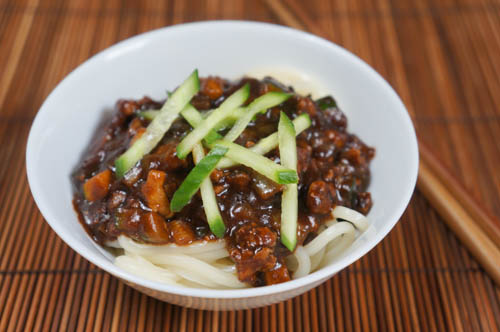
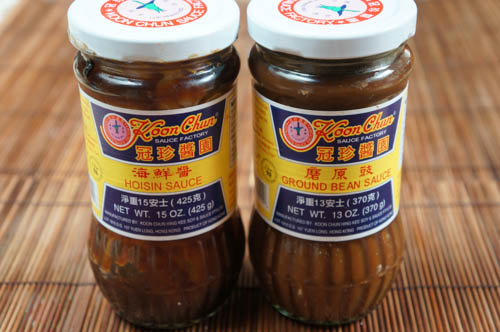
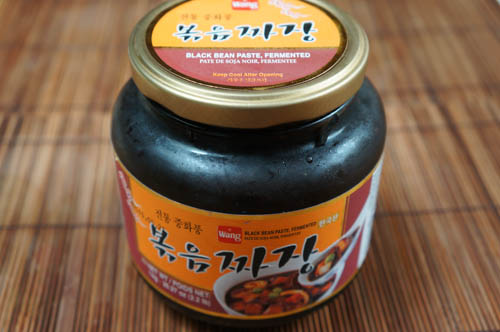
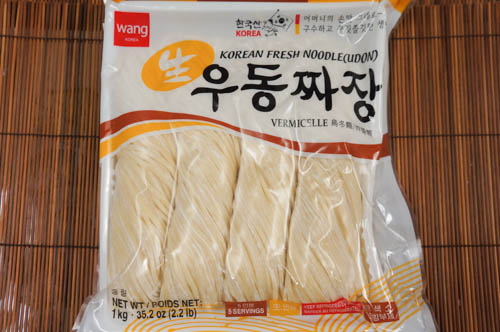
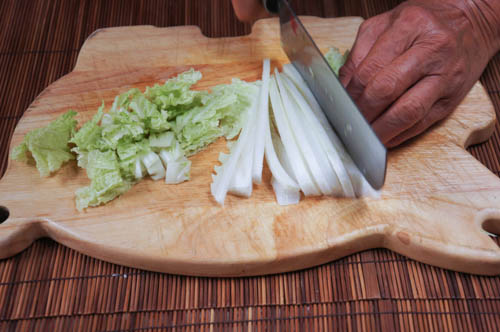

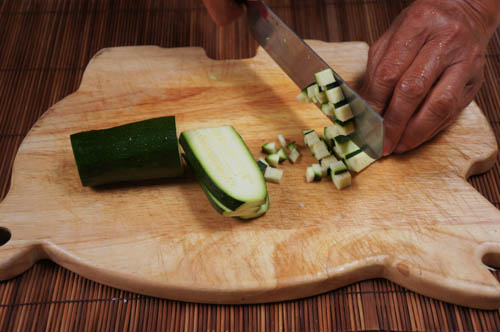
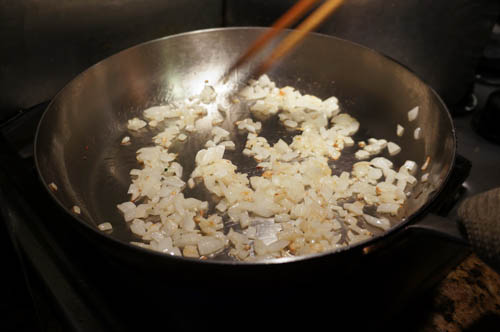
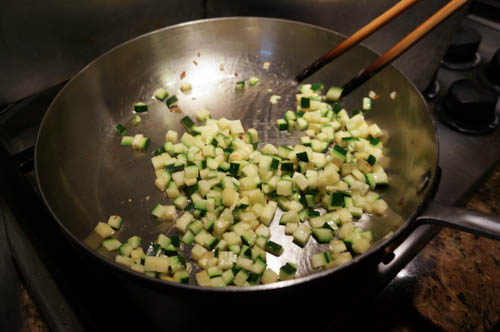
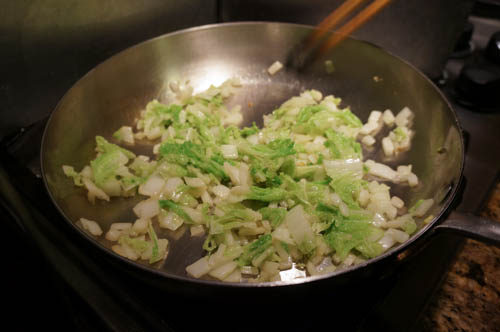
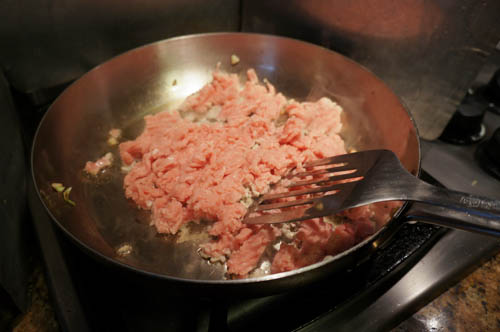
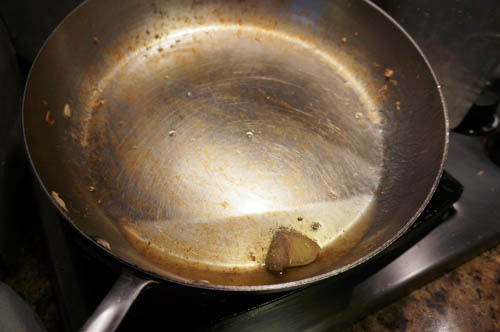
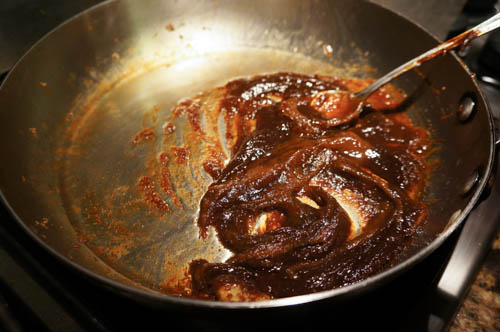

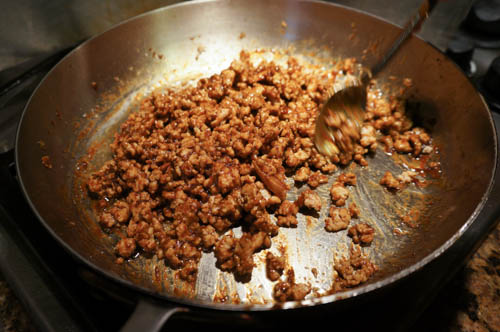
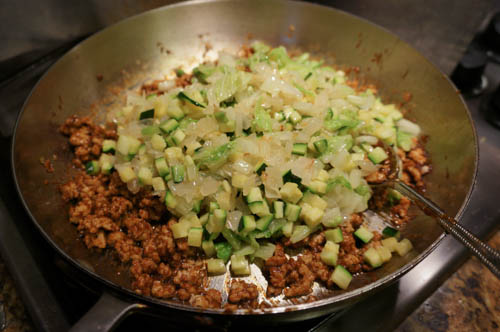
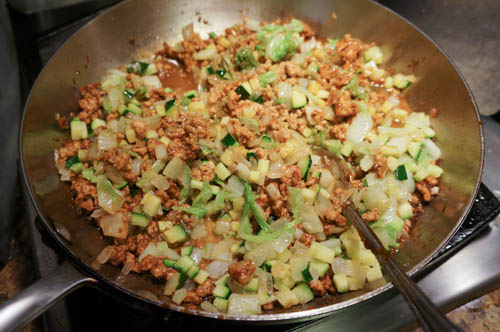
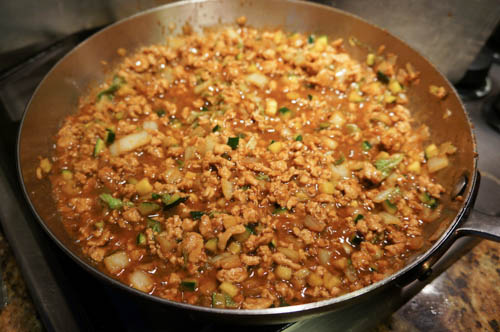
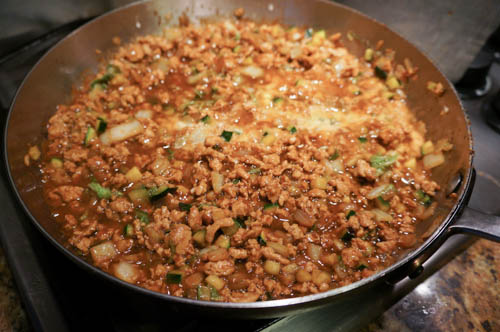
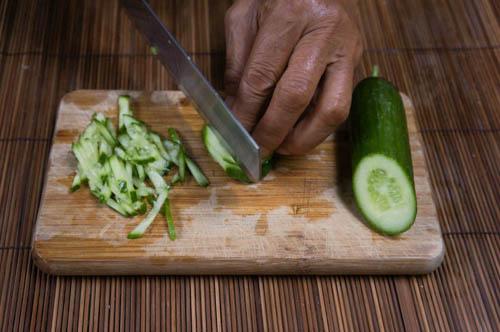
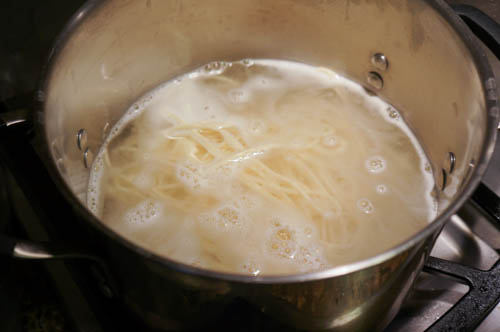
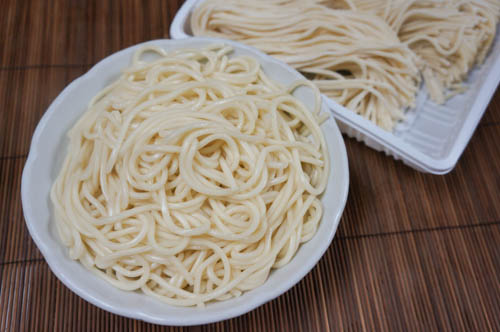
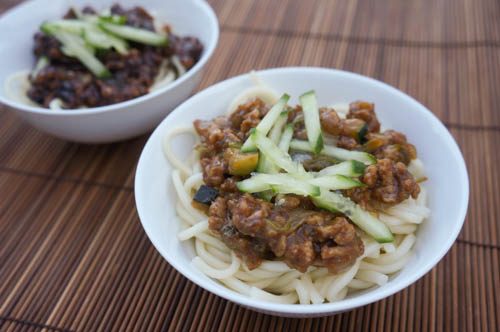
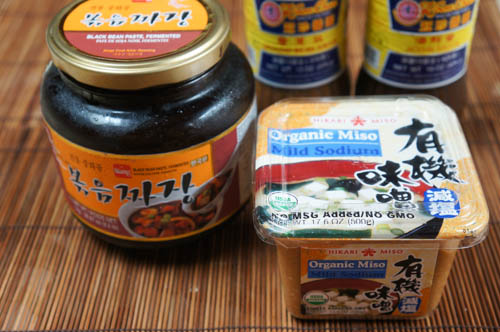
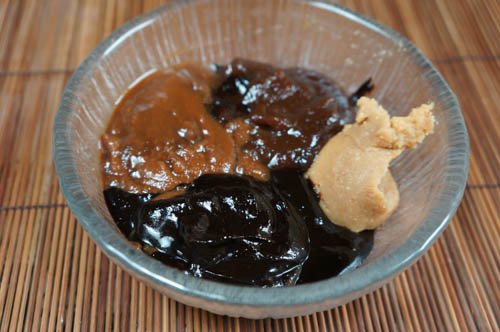
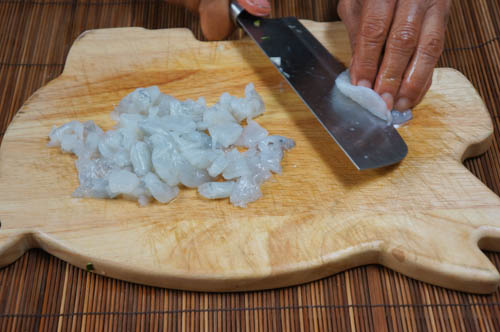
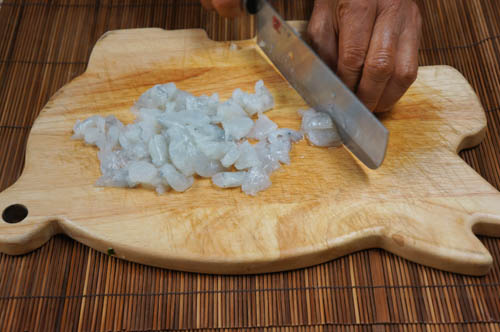



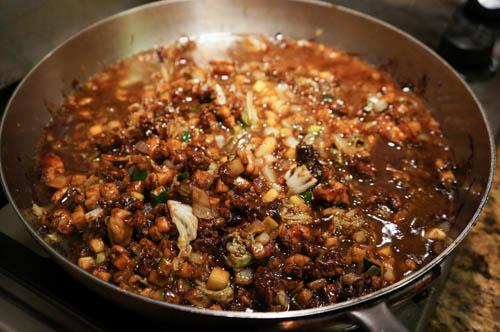
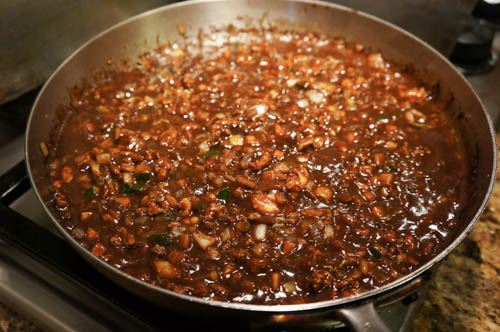




Such a beautiful story behind this droolworthy zha jiang mian, Lilian, And it’s so fascinating to read about the interplay between the Korean and Chinese influences in this dish. I’ve only ever had my mother’s zha jiang mian growing up, but B2 swears by a version he grew up with in Honolulu (at a Korean-Chinese restaurant — now it all makes sense!) that looks closer to yours. I’m wondering if it’s the chunjang! Now I’m super excited to give your version a try. Hopefully it’s the version B2’s been craving 🙂 Thank you so much for sharing your thoughtful words and reflections, as always, and for this recipe!
yes, the chunjang is transformative! i hope it satisfies b2’s craving – there really is no substitute for zha jiang when you crave it. =) btw, i haven’t had it in a few years, but the zha jiang at shanghai gourmet on mott is pretty good (and the soup dumplings are the BOMB).
HELLO CHINESE GRANDMA, HOW ARE YOU? I HOPE YOU ARE WELL. WHAT THE FRICK HAPPENED TO THE WEBSITE?
hello concerned chinesegrandma enjoyer – you seriously warmed my heart! thank you for checking in on me. i am well and miss being here. when i’m pulled away for a while, i am always unsure about how to come back. i appreciate your encouragement, and i promise i am working on words to answer your question. xo, cg
Your posts always make me feel homey and comfy. The recipe and the back story is amazing and I would like to try making Zha jiang mian. Thank you for all you share on Chinese Grandma.
aww laurel, that is so nice! thank you for reading. =)
Don’t think that I’ve ever had it. My hubby loves it though. His mom’s family is from China near Korea, too. In fact a lot of times she’s mistaken for being Korean.
gotta try it, slammie! good stuff.
Thank you for this post! I’ve eaten it all my life too, but to hear some history around the dish is really neat.
yay linda, another born and bred zha jiang eater! glad you enjoyed the history. =)
Fab post. Totally enjoyed it. My history is weak in regard to your parents situation. Your photos and commentary are spot on for directions. Thank you.
thank you, carol!
What a lovely post. Beautiful writing and beautiful food. I can’t wait to go home and make this. We met at the ifbc conference and I did not realize that THIS was your blog. I have been reading it for awhile now and absolutely love it!
One thing I’d like to point out. When you say zha jiang mian is a Chinese and Korean hybrid that is wrong. Zha jiang mian is an original Chinese dish with no Korean influence.
Chinese restauranteurs went to Korea and made a different version over there with local ingredients. Btw if you ask a typical Korean, their zha jiang mian is 100% Korean. Usually they are shocked and amazed to hear that there is zha jiang mian in China.
hi mike – you are right, zha jiang mian is definitely a chinese dish. but the zha jiang mian that has become so popular among koreans incorporates chunjang sauce, which makes it a hybridized version of the original chinese dish. thanks very much for your input!
Pizza is polular in America. It’s been Americanized. But it’s still considered an Italian dish.
Hi cg:
I stumbled across your blog when searching for a zhajiangmian recipe. It’s one of my favorite dishes from childhood.
Getting a kick out of our similarities, too. I’m a mom of three, was born in California, met (in NYC!) and married a Midwesterner and live in the Midwest now near his family. I even did a stint as an investment banker!
My mother’s family is from Shandong and I am always, always mistaken for Korean. Look forward to trying out the ultimate version (and reading more).
hi grace – my long-lost twin! =) you are awesome for writing, this is so much fun. i hope you try the zha jiang – such great comfort food, especially for us shandong peeps. so glad you found me here – stay warm in the midwest! crazy but it’s 70 degrees in the bay area today.
I absolutely loved your family story behind the dish. It’s been my favorite food since I was a kid (I still remember my first time seeing it delivered in the giant metal box and eating it in my grandfather’s office in Seoul when I was five), but I didn’t know the history behind it. Living in Hong Kong, I learned about how wars brought non-Canton foods with refugees that became Hong Kong staples. I didn’t realize the same process brought this to Korea too–knowing the human resilience behind it makes it more nourishing.
hi darcy – thank you for your wonderful comment…i am so glad the story resonated with you!
CG-this was a huge hit for my 80 year old father-many thanks to you but especially your wonderful beautiful and talented mother who walked me through this so recipe so lovingly! It was a great Father’s Day gift for my dear old dad! He loved it!!!!!
This recipe is fantastic! I’ve used it a few times and it never disappoints. A common variant served where I grew up (Taiwan) substitutes dry tofu for meat. Not only does it still taste great, it also has the side effect of producing one of the tastiest vegetarian dishes ever 🙂
hi jerry – so glad you love this recipe as much as i do! i LOVE the dry tofu recommendation and am excited to try it. thanks so much for sharing back!
Hello, I was trying to find a good Zhajiangmian recipe for a school project and stumbled upon this and it looks amazing! Is the ground bean sauce the same as tianmianjiang (甜面酱 technical translation: sweet noodle sauce, or fermented bean sauce, the thing used to dip duck in)?
hi catherine – ground bean sauce is this one on Amazon. it’s not sweet – pasty and salty. the one with duck is hoisin sauce…darker, smoother and sweet. good luck!
You saved my life. My Chinese exchange student does not like any American food. This is the first dish I cooked that she loved. Thank you.
hi launi – what an amazing host mom you are! i feel for you – chinese home cooking is so different from the chinese food we know from restaurants here. honestly your exchange student might be happy with sticky rice (kokuho rose is a good brand, widely available) and some stir-fried vegetables, or a fried egg. or even a hard-boiled egg, with a little dish of soy sauce for dipping. best of luck to you!
I was born in Korea and spent many years in Taegu. I lived on Oahu for over 20 years and I’ve had great zhajiangmien in both places. There is also a Mandarin restaurant in Macon, GA that has it pretty good not on the menu so you have to ask. Even in Indianapolis at the oriental inn they have jia jang mien. Not on menu again you have to ask. Someone will make a killing on this because it is so onolishes. Thanks for the recipes.
Koreans like to eat it with kimchee , raw onions with vinegar and chunjang sauce and yellow daikon radish and I like to put kochugaru (Korean hot paper flakes) in my dish.
hi sam – great tips, thank you for sharing! kimchee and daikon make everything better. =)
Thanks for this recipe! I ran into this dish at a restaurant, and really wanted to recreate it at home! I added a bit of cayenne pepper to it for a bit of a kick, similar to the restaurant, and it tastes almost exactly alike! It’s delicious! Thank you so much for posting this!
hi nef – i got so behind on comments…thank you for this, i am so glad it worked out for you!
Sorry. This dish is Korean in origin. Please stop spreading misinformation.
hi marcus – i beg to differ, both based on my parents history of their region, from which the dish originated, and from independent sources (https://en.wikipedia.org/wiki/Jajangmyeon). but we can certainly agree to disagree. i appreciate you taking the time to comment!
Jja Jang myeon is indeed a food born on the Korean peninsula. Though it was first created by Chinese immigrants, it was still created in Korea first. it was not “brought over” by these immigrants as the food tastes completely different and uses different ingredients.
And most Chinese people didn’t even know what jja Jang myeon was 20 years ago until the Korean Wave took off. I would ask my Chinese friends in America what this was and they had no clue or even knew anything that remotely looked or tasted like it. it’s become popular due to Korean dramas and its so typical of Chinese people to try and claim it as their own.
Most Koreans living in Korea erroneously think jja jangmyeon is of Chinese origin because it is called “Chinese food” in Korea. However, it was created by Chinese immigrants who first started selling this dish in Korea – yes, the first jja jangmyeon was made on Korean soil – you would not be able to find this dish in China at the time as it uses different ingredients and has a completely different taste, much like spaghetti vs jja jangmyeon. If you disagree then one can argue anything with noodles and a sauce are Copy cats of each other.. Then is spaghetti and zha Zang myeon the same? No, they may both have noodles, meat, and a sauce but they use different ingredients for the sauce and therefore taste completely different. Same principle with jja Jang myeon and the Chinese dish — they are not the same food. if you order it in China thinking you will get the same dish you will be sorely disappointed as the sauce is different and doesn’t even taste anything alike!
Thank you SO MUCH for posting this – it was the history that I was searching for. I knew jjajangmyun and chunjang had Chinese roots and no one ever explained exactly how. I just wish I knew how to make chunjang because I don’t like all the chemical additives in the ones available. I am also (and have been for some time) COMPLETELY fascinated with Chinese noodle-pulling!
Thank you, this turned out delicious! I have always gotten this in the restaurants because I didn’t know how to make this. I finally wanted to learn to make this to take to a potluck. I and my kids really like this a lot and they have not complained about having to eat it for 3 days in a row now! 🙂 I especially like that the recipe uses ground turkey instead of pork, that it does not use mushrooms (because my husband and kids hate mushrooms) and that there are so many veggies in it. I am also surprised to find that most of the sauces do not have msg added to them! Only the Korean fermented black bean sauce has msg in it so I used a Chinese black bean and garlic sauce instead. Even with all those salty sauces, since there was no msg. I did not have any trouble sleeping or have to get up in the night desperate for water like I usually do when I get this dish at restaurants. Thank so much!
hi linda, this is so great! sorry i got behind on my comments. really happy this worked out for you so you can keep zha jiang mian in your life! =)
Loved your post… I am Korean American who worked in China for 7 years, where I got to discover the different variation from province to province… One variation you can try to elevate the dish is… Make dry version of sauce, top it with a poached eggs…let the runny yoke dillute the sauce as you mix. Enjoy.
hi jk – i love this. i am definitely on team runny egg – makes everything better! thank you so much for sharing the idea.